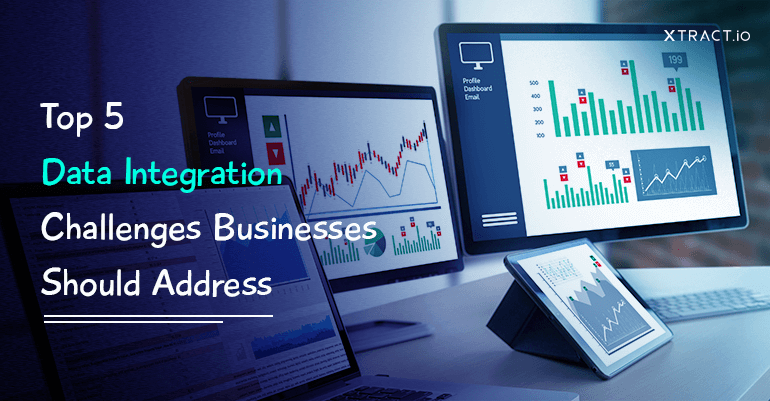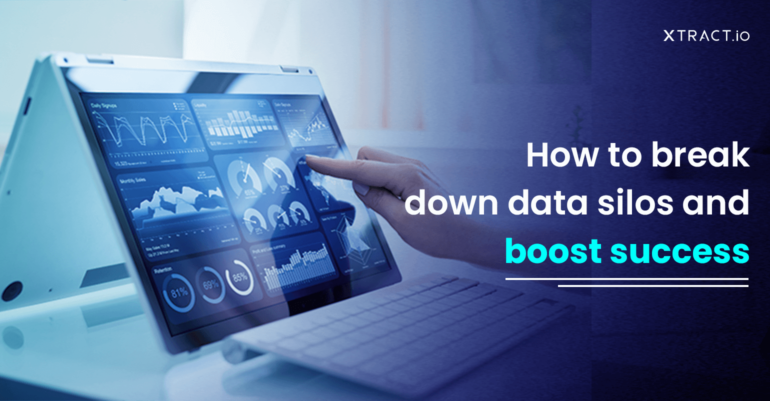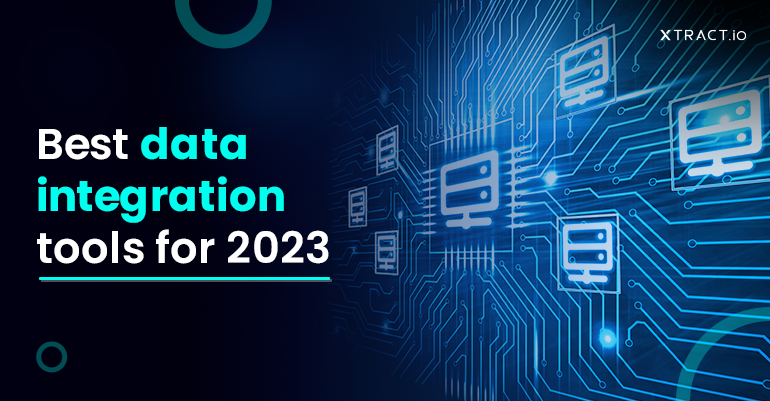In today’s digital age, data is more critical than ever for businesses to succeed. Data can help companies make informed decisions, optimize operations, and gain a competitive advantage in their industry. With the rise of technology, businesses can collect and analyze large amounts of data, giving them insights into market trends and performance. Organizations require a comprehensive solution that can integrate data from multiple sources into a unified view. Xtract.io’s data integration platform offers you this!
Data integration has become increasingly important today as companies generate more data than ever. As we head into 2023, several emerging trends in data integration are poised to revolutionize how organizations handle their data. Read further to explore these trends.
What is data integration?
Data integration is a process that enables organizations to make sense of the vast amounts of data they generate and collect. It combines data from different sources and systems to create a unified view of information that can be easily analyzed and used for business decision-making. This can include merging data from different systems, databases, or file formats. Further, data integration allows businesses to break down data silos and access the insights they need to enhance their decision-making processes, improve their operations, and drive growth.
For example, a marketing agency may have data on customer behavior from various sources, such as social media, email campaigns, and website analytics. Integrating data allows the company to identify customer preferences, purchase behavior, and engagement levels across different channels. This can help them create more targeted and effective marketing campaigns, increasing customer loyalty and revenue growth.
Why does your business need a good data integration solution?
Data integration is a crucial process for businesses of all sizes and industries. Here are some of the benefits that businesses can expect when they integrate data:
- Enhanced decision-making: Integrated data provides a complete picture of business operations, enabling better decision-making. This can lead to insights that businesses cannot obtain from isolated data sources, helping them identify trends and opportunities.
For instance, retailers can use data aggregation to analyze customer feedback and identify areas where they need to improve their products or services. They can also use the data to predict demand for certain products and adjust their inventory levels accordingly to avoid stockouts and overstocks.
- Increased efficiency: Data aggregation streamlines and simplifies the data handling methods. Automating repetitive and time-consuming data-related tasks can reduce manual effort and errors. This can save businesses time and resources, allowing them to focus on their core activities.
Flipkart, the Indian e-commerce company, uses data aggregation to optimize its supply chain management. By aggregating data from different sources like inventory, customer demand, and shipping times, they can identify trends and improve inventory management and delivery times. Further, it enables Flipkart to understand customer needs and preferences, making personalized recommendations and promotions, saving time and effort for both the company and the customer.
- Improved customer experience: Data integration can help businesses provide a more personalized experience to customers by aggregating data from multiple sources. This helps businesses understand customer needs and preferences and tailor their products and services accordingly.
For example, Amazon uses data to provide personalized recommendations to customers. By analyzing a customer’s purchase history, browsing behavior, and demographic information, Amazon can identify patterns and suggest products in which the customer is more likely to be interested. This helps to improve the overall shopping experience by reducing the time, and effort customers need to spend searching for products, making it more convenient and enjoyable.
- Better collaboration: Data integration can improve collaboration between departments, teams, and geographically dispersed offices. It allows teams to work with the same data sets and make better-informed decisions.
Suppose a company has multiple departments, each using a different software system to manage its data. The sales team might use one software, the marketing team might use another, and the customer service team might use a different one. As a result, each team has its data silo, and sharing information across teams is challenging. The company can consolidate data from each system into a centralized database using data aggregation tools, making it easier for different departments to access and share information.
Data integration trends: 2023
As we move into 2023, data integration continues to be a crucial aspect of modern business operations. Here are some emerging trends to keep an eye on in the world of data integration:
Hybrid integration platform
A hybrid integration platform (HIP) is a solution that enables businesses to integrate data across various systems and applications, both on-premises and in the cloud. The platform provides a centralized location for data integration and management, making it easier for businesses to manage their data and ensure consistency across all systems. It also often includes features like API management, data mapping, workflow orchestration, and event-driven architecture. Further, the goal of a HIP is to simplify the integration process by allowing businesses to use a single platform to manage all their data integration needs. As a result, HIPs are becoming increasingly popular as businesses continue to adopt cloud-based systems and look for ways to manage their data more efficiently.
Enterprise application integration
Enterprise application integration (EAI) is a process that connects different software applications within an organization to enable them to communicate and work together seamlessly. EAI aims to ensure that the different applications used in an organization can exchange data and work together efficiently. By integrating different systems, organizations can improve communication, streamline workflows, and reduce manual processes. EAI typically involves using middleware, which acts as a bridge between different applications, enabling them to communicate with each other. Further, with EAI, organizations can improve efficiency and reduce costs by minimizing manual data entry and reducing the likelihood of errors.
Enterprise integration platform as a service (EiPaaS)
Enterprise integration platform as a service (EiPaaS) is a cloud-based service that allows businesses to connect their various applications and systems in a more efficient and streamlined way. It provides a central hub for data exchange, where all the different programs and platforms can communicate and share information. Hence, EiPaaS can help companies save time and resources by automating many processes to integrate different software applications. Further, it can also help reduce errors, improve data accuracy, and provide better visibility into business operations by consolidating data into a single location. Hence, EiPaaS can be a valuable tool for businesses looking to improve their efficiency and productivity.
Hybrid integration Vs. Traditional data integration
A Hybrid integration platform (HIP) differs from a traditional data integration platform in several ways. While a data integration platform typically focuses on integrating data from various sources, a HIP is a more comprehensive solution with multiple integration techniques. It supports hybrid environments with a mix of on-premises and cloud-based systems. Further, HIP offers additional capabilities such as data mapping, application programming interfaces (APIs), and business process management.
Unlike data integration platforms, HIPs are designed to support the growing need for agile and flexible integration solutions that can handle the complexity of modern IT environments. Additionally, HIPs often incorporate advanced features like artificial intelligence (AI) and machine learning (ML) to improve data integration processes’ speed, accuracy, and scalability.
In summary, data integration is essential for any business that wants to make the most of its data and stay ahead of the competition. Xtract.io’s data integration platform offers a comprehensive solution to help businesses seamlessly combine and analyze data from multiple sources. The platform’s user-friendly interface and advanced features allow you to extract data easily, clean and transform data and create unified data sets. Request a free demo!








